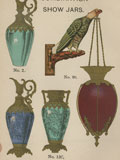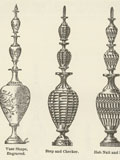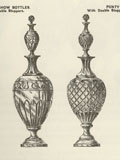
What Are the True Origins?

While the exact time and place of their creation is unknown, large vessels used for storing goods have been documented throughout history, such as the Persian "qarabah" for wine or the British gallipots for solid extracts or ointments, which may have influenced the development of the apothecary's show globes. Despite the many theories surrounding the origins of show globes, there is one similarity that appears in almost all of the stories, which suggests that this is the truth. Many of the tales involve Anglo-Saxon roots, thus the globes probably originated in Britain and were later introduced to countries under British influence, such as the United States, Canada, Australia, and New Zealand.
Development in Britain

Despite the influence or origin, these colorful show globes were common place in English nations by the eighteenth century, because there were published directions on how to prepare the colors to fill these popular globes. For example, a crimson or pink color could be made by dissolving nickel in nitric acid and adding a cobalt in ammonia solution. Blues and purples could be made by dissolving copper sulfate in an ammonia and water solution. By the beginning of the nineteenth century, British pharmacies displayed carboys in their shop front windows sometimes as their sole window décor, as depicted on trade cards from London and Leamington. Later, show globes expanded their role and became a symbol of "druggists and chemists" on their signs and advertisements.
Development in America

By 1789, show globes were exported to the United States, as publicized in New York advertisements, followed soon after by Canada, Australia, and New Zealand. Until the mid-nineteenth, American catalogs contained few illustrations, but the Bullock and Crenshaw company presented the first extensive collection of pharmacy equipment illustrations in the 1850s. By the 1870s, catalogs contained many illustrations, and during the 1890s, they contained color representations of show globes and other supplies. By 1890, several American manufacturers, including the Whitall, Tatum Company, began to make variations of these simple glass decorations by incorporating gas or oil lighting from inside, and later electricity, which served as a precursor to the electric neon sign.